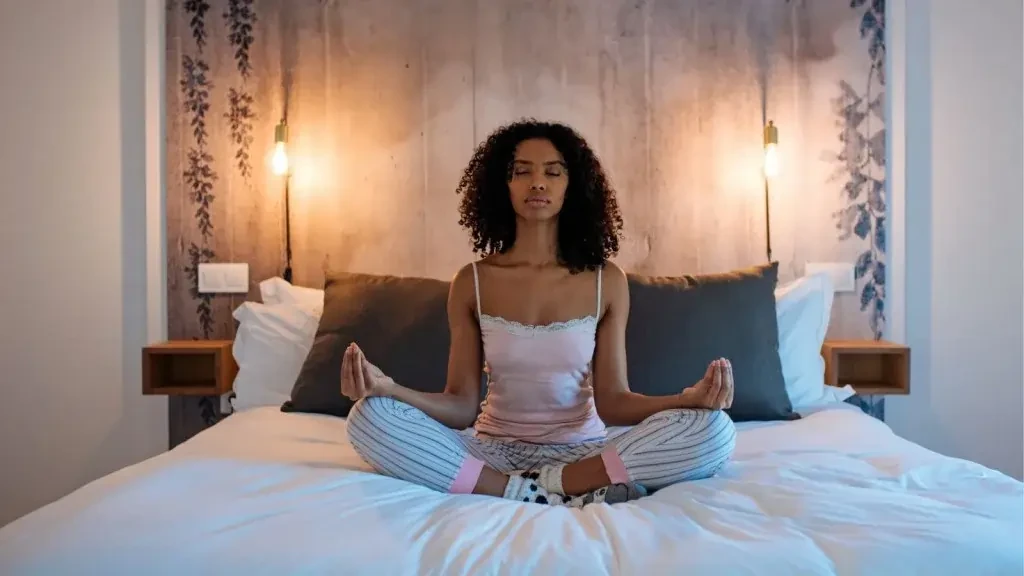6 Yoga Moves for Period Cramps: Find Instant Relief
Period cramps can be a challenging and uncomfortable part of the menstrual cycle. While medication and rest are common remedies, yoga offers a natural and effective way to ease the pain.

With easy-to-use, beginner-friendly bed meditation practices, you can transform your nights. Discover how to unwind physically and mentally so that you can go asleep peacefully.
Meditation has been used in a tremendous way in modern times as a mechanism for reducing stress and promoting well-being and inner peace. This might be especially appealing for newcomers to this kind of journeying, as getting started can happen from the comfort of one’s own bed. Here, I will explain how to meditate in bed and include the fundamental instructions to follow when engaging in the same, as well as the benefits of bed meditation.
Convenience and comfort:- Practising meditation in bed is one way that can help the beginner since it does not force him or her out of the comfort of the bed to practice. This reduces distractions from external sources and also assures formality since the atmosphere resembles a more relaxed home setting.
Ideal for morning and night:- Meditation performed while one is still in bed is suitable for both the morning and the evening. By doing it in the morning, it can be programmed for the rest of the day, while doing it in the evening makes it easier on the mind and helps one sleep well.
Easy to Integrate into Routine:- Meditation in bed does not have any requirements in terms of accessories or specific positions; there is no setup time involved.
Creating a conducive environment for meditation is crucial, even if you're in bed.
Breathing is a fundamental aspect of meditation. It helps center your mind and brings your attention to the present moment.
A body scan helps you connect with your body and release tension.
Visualization can be a powerful tool to deepen your meditation.
Mindfulness involves being fully present and aware of the moment without judgment.
Loving-kindness meditation, or Metta, focuses on cultivating compassion and kindness towards yourself and others.
Concluding your meditation session mindfully is important.

Improved sleep quality:- Practicing meditation before sleep can make the body and mind paralyzed and reduce the level of tension. This is because it affects the amount of time it takes to sleep as well as increases the quality of sleep since it brings minimal stress and/or anxiety.
Reduced stress and anxiety:- Practicing meditation every day when performing work activities may help one cope with stress and anxiety. The stress hormone cortisol is reduced when this system is set in motion and the body is basically put in rest mode.
Enhanced focus and concentration:- Meditation enhances concentration by commanding the mental faculties through the principles of staying focused on the present moment. This is particularly advantageous in the enhancement of efficiency and productivity and in accomplishing the fundamental tasks on any given day.
Emotional Well-Being:- Loving Kindness Meditation can be beneficial for the enhancement of positive affect and the decrease of negative affect. It helps to develop a feeling of interpersonal empathy, improved compassion, and thus all-embracing interpersonal relations.
Pain Management:- Specifically, mindfulness meditation appears to work by changing the way people interpret and feel about their pain. It enhances tolerance to pain, and in turn, it helps humans manage the pain they feel in their bodies.
Better Self-Awareness:- In particular, it is used in self-awareness development, as meditation leads to introspection and focused attention. Giving focus to how you perceive things, feel, and act, which overall makes you a better person or for others, helps you in self-enhancement.
Consistency is key:- Like any skill, meditation requires regular practice. Aim to meditate at the same time each day to establish a routine.
Start Small:- Begin with short sessions, such as 5–10 minutes, and gradually increase the duration as you become more comfortable with the practice.
Be patient and compassionate:- It’s normal for beginners to struggle with maintaining focus. Be patient with yourself, and approach each session with a sense of curiosity rather than judgment.
Use guided meditations:- If you find it challenging to meditate on your own, consider using guided meditation. There are numerous apps and online resources available that offer guided sessions for various meditation styles.
Keep a journal:- Keeping a meditation journal can help you track your progress and reflect on your experiences. Note any insights, challenges, and changes you observe over time.
The concept of a meditation bed is another way to practice early morning meditation indirectly. It provides a comfortable environment that is easy to manage as compared to other competing environments, thus enabling one to be comfortable and free. It has been proven that practicing meditation in the morning or evening, before sleep, has quite a number of positive effects: it helps to improve sleep quality, reduces stress levels and illnesses connected with it, increases working capacity, and improves overall psychological state.
So, always remember the concept of self-practice, where the journey of meditation is an individual process. When it comes to gender roles, there is no one right or wrong way of doing them. The goal is to figure out the most effective technique to manage stress and then stick with it. Over time and with constant practice, one can make meditation more and more useful, especially in the nurturing of the mind, body, and spirit.
Period cramps can be a challenging and uncomfortable part of the menstrual cycle. While medication and rest are common remedies, yoga offers a natural and effective way to ease the pain.
Discover the best yoga exercises for weight loss designed specifically for women. Our comprehensive guide features effective routines and tips to help you shed pounds, boost metabolism, and enhance overall wellness. Perfect for beginners and seasoned practitioners alike!
Explore our blog for five straightforward strategies to ease stress and find serenity in your hectic life. Whether you're struggling with work pressure, personal challenges, or just the fast pace of modern living, our guide offers easy-to-implement solutions to help you relax and rejuvenate.
